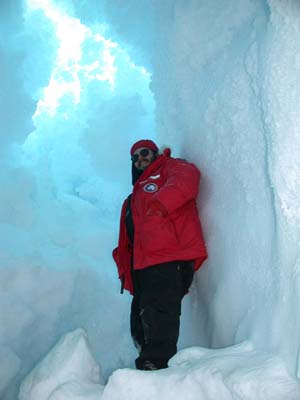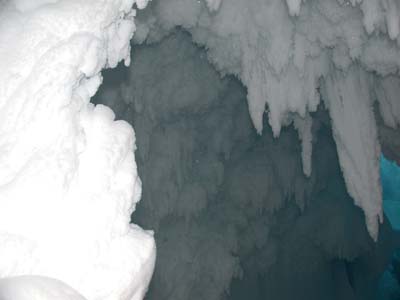TIGER in Antarctica
November 23, 2001
Ice Caves
 Before we leave the area around Scott's hut, the terrain here is definitely worth mentioning. While most of the island is also black volcanic rock, here there are tremendously varied lava bombs strewn about the landscape in an almost surreal fashion. The sizes go from fist-sized up to man-sized. The one pictured at right, with Erebus in the background, is about 4 feet high. It's clear evidence that Mt. Erebus hasn't always been the slow, steady volcano it is today.
Before we leave the area around Scott's hut, the terrain here is definitely worth mentioning. While most of the island is also black volcanic rock, here there are tremendously varied lava bombs strewn about the landscape in an almost surreal fashion. The sizes go from fist-sized up to man-sized. The one pictured at right, with Erebus in the background, is about 4 feet high. It's clear evidence that Mt. Erebus hasn't always been the slow, steady volcano it is today.
Photo on right: Lava bomb from Erebus
 Then we start heading back in the direction of McMurdo. But first we stop at the Erebus glacier ice tongue, a long, thin peninsula of ice that extends well out past shore into the pack ice. Just before we get there we pass a seal research center and I see my first wild seals. We are forbidden to stop, it would disturb the research, but we can clearly see about a dozen Weddell seals lounging on the ice.
Then we start heading back in the direction of McMurdo. But first we stop at the Erebus glacier ice tongue, a long, thin peninsula of ice that extends well out past shore into the pack ice. Just before we get there we pass a seal research center and I see my first wild seals. We are forbidden to stop, it would disturb the research, but we can clearly see about a dozen Weddell seals lounging on the ice.
Photo on left: Inside the ice cave
On the edge of the glacier, there are a couple of navigable ice caves, one small and one larger. These are essentially crevasses that have been capped over by snow, but moved to the edge of the glacial tongue so you can go in the side. It is pretty common for snow to make a "roof" over a crevasse, and this is an extremely dangerous situation. A crevasse that you can see is beautiful, one that gives no indication until you break through the cap can be deadly.
 Unlike Scott's hut, it is very light in the caves, with the incredible blue glow of glacial ice. Pictures just don't really do it justice. The larger cave can be walked into. There are icicles and crystalline formations on the ceiling and some places on the wall. You can see structure in the ice above by the light that is filtering in.
Unlike Scott's hut, it is very light in the caves, with the incredible blue glow of glacial ice. Pictures just don't really do it justice. The larger cave can be walked into. There are icicles and crystalline formations on the ceiling and some places on the wall. You can see structure in the ice above by the light that is filtering in.
Photo on right: Standing in the ice cave
 The smaller cave has a tunnel into it that requires sliding on my belly for about 20 feet. Only three people are allowed in the cave at one time. There is a ledge at the end of the tunnel, but there is also a five foot drop on one side and my leg slides into it. But the other two people in the cave grab me and I don't slide down. I don't think I would have gotten hurt, it is possible to go down in a controlled manner, but getting up is notoriously difficult.
The smaller cave has a tunnel into it that requires sliding on my belly for about 20 feet. Only three people are allowed in the cave at one time. There is a ledge at the end of the tunnel, but there is also a five foot drop on one side and my leg slides into it. But the other two people in the cave grab me and I don't slide down. I don't think I would have gotten hurt, it is possible to go down in a controlled manner, but getting up is notoriously difficult.
Photo on left: Inside the ice cave
There is a nice short path between the two caves, but after a number of trips used it, it was noticed that the "path" was the cap of a crevasse that was opening up. It is now marked with black flags, the symbol of danger, and we have to go a little farther around. You can see the flags on the large version of the picture at the bottom.
 As people finish up their tours of the caves, the group kicks back and relaxes on the ice. It is a beautiful night, clear and calm. Looking at the picture on the left, it is hard to believe that it was taken after 11 PM.
As people finish up their tours of the caves, the group kicks back and relaxes on the ice. It is a beautiful night, clear and calm. Looking at the picture on the left, it is hard to believe that it was taken after 11 PM.
Photo on right: Outside the ice caves
On the way back to town, I talk my way into riding "shotgun" up in the cab of the Delta. Although the Delta isn't allowed to stop, the driver does slow down and I get a few pictures of the seals. You can see one of the pictures on my wildlife page.

Dr. Eric R. Christian
Eric's Featured Scientist Profile
This page was last modified on December 19,
2002
|